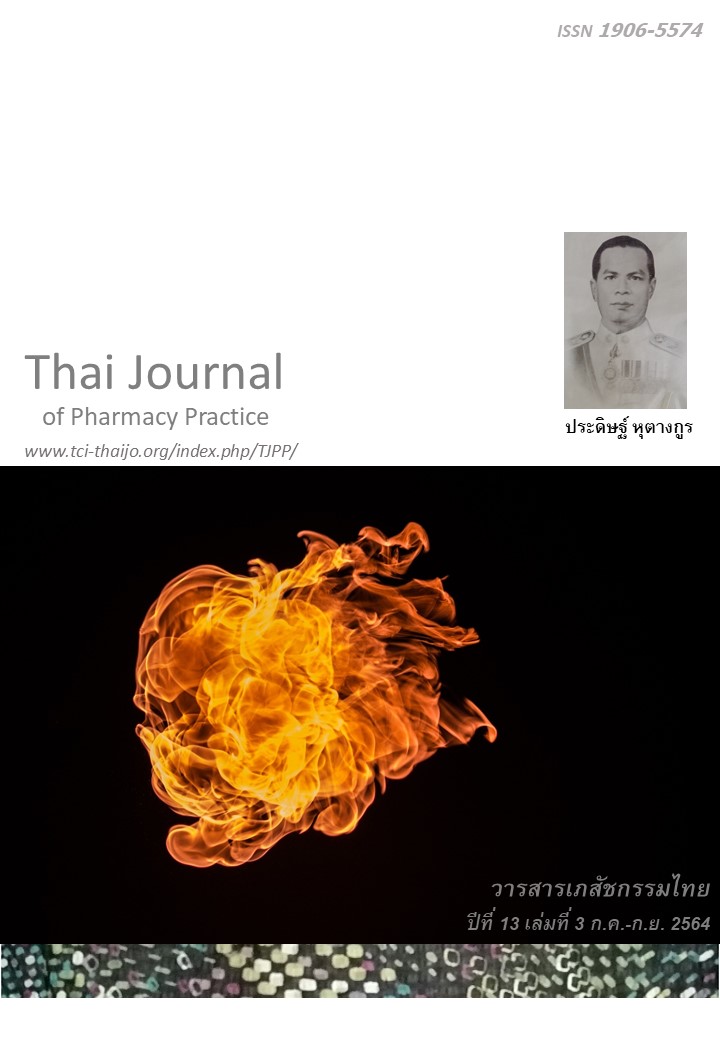การหายของแผลบาดเจ็บและการดูแลตนเองของผู้ป่วยที่ ไม่ได้รับยาปฏิชีวนะ ณ โรงพยาบาลของรัฐแห่งหนึ่ง
Main Article Content
บทคัดย่อ
วัตถุประสงค์: เพื่อศึกษาอัตราการหายของแผลบาดเจ็บที่ผิวหนังและการดูแลแผลด้วยตนเองของผู้ป่วยนอกแผนกอุบัติเหตุฉุกเฉินที่ไม่ได้รับยาปฏิชีวนะ ระเบียบวิธีวิจัย: การวิจัยครั้งนี้เก็บข้อมูลจากการโทรศัพท์ในวันที่ 7 หลังการรักษาในผู้ป่วยนอกแผนกอุบัติเหตุฉุกเฉินที่เกิดแผลและไม่ได้รับยาปฏิชีวนะ การสัมภาษณ์ครอบคลุมการหายของแผล อาการทางคลินิกที่บ่งชี้ถึงการติดเชื้อที่แผล และการดูแลแผลด้วยตนเอง ผลการวิจัย: ตัวอย่าง 362 ราย เป็นเพศชายร้อยละ 58.3 อายุเฉลี่ย 27 + 18 ปี ตัวอย่างเกิดบาดแผลถลอก ร้อยละ 60.2 และมีบาดแผลฉีกขาดร้อยละ 38.7 ตัวอย่างร้อยละ 45.5 มีแผลหายสนิท อีกร้อยละ 55.5 แผลดีขึ้น แต่ยังมีรอยแดง หรือสะเก็ดแผล ไม่พบผู้ป่วยที่มีอาการทางคลินิกบ่งชี้ถึงการติดเชื้อที่แผล ได้แก่ ฝี หนอง ปวด บวม แดง ร้อนที่บริเวณแผล หรือมีไข้ ด้านการดูแลแผลด้วยตนเอง ตัวอย่างส่วนใหญ่ล้างแผลที่บ้าน (ร้อยละ 50.8) มีการล้างแผลทุกวัน ร้อยละ 76.2 ใช้น้ำเกลือปราศจากเชื้อร้อยละ 75.9 ใช้แอลกอฮอล์ ร้อยละ 56.1 ใช้โพวิโดนไอโอดีน ร้อยละ 25.4 ตัวอย่างรายงานว่า แผลโดนน้ำจากการอาบน้ำ ร้อยละ 40.1 ลักษณะทางคลินิกที่เกี่ยวกับผู้ป่วยและบาดแผลไม่มีความสัมพันธ์กับการหายของแผล แต่สถานที่ทำแผล ความถี่ และน้ำยาล้างแผล มีความสัมพันธ์กับการหายของแผลอย่างมีนัยสำคัญทางสถิติ (P<0.001) สรุป: ยังไม่มีความจำเป็นที่ต้องใช้ยาปฏิชีวนะในแผลบาดเจ็บที่ทำให้สะอาด แต่การปฏิบัติตนในการดูแลแผลอย่างถูกต้องมีผลต่อการหายของแผล จึงควรให้ความสำคัญกับการประเมินบาดแผล ความรู้ และการล้างแผลด้วยตนเองเพื่อป้องกันการติดเชื้อและส่งเสริมกระบวนการหายของแผล
Article Details
ผลการวิจัยและความคิดเห็นที่ปรากฏในบทความถือเป็นความคิดเห็นและอยู่ในความรับผิดชอบของผู้นิพนธ์ มิใช่ความเห็นหรือความรับผิดชอบของกองบรรณาธิการ หรือคณะเภสัชศาสตร์ มหาวิทยาลัยสงขลานครินทร์ ทั้งนี้ไม่รวมความผิดพลาดอันเกิดจากการพิมพ์ บทความที่ได้รับการเผยแพร่โดยวารสารเภสัชกรรมไทยถือเป็นสิทธิ์ของวารสารฯ
เอกสารอ้างอิง
DataStellar Co., Ltd. Medical Dictionary Database 2010. Definitions of Wound and Injury [online.] 2020 [cited Apr 21, 2020]. Available from: www.dictionar y.net/wounds%20and%20injuries
Heal CF, Banks JL, Lepper PD, Kontopantelis E, van Driel ML. Topical antibiotics for preventing surgical site infection in wounds healing by primary intention. Cochrane Database Syst Rev 2016; 11: CD011426. doi:10.1002/14651858.CD011426.pub2
Worster B, Zawora MQ, Hsieh C. Common questions about wound care. Am Fam Physician 2015; 91: 86-92.
Saco M, Howe N, Nathoo R, Cherpelis B. Topical antibiotic prophylaxis for prevention of surgical wound infections from dermatologic procedures: a systematic review and meta-analysis. J Dermatolog Treat 2015; 26: 151-8. doi:10.3109/09546634.2014 .906547
Tong QJ, Hammer KD, Johnson EM, Zegarra M, Goto M, Lo TS. A systematic review and meta-analysis on the use of prophylactic topical antibiotics for the prevention of uncomplicated wound infections. Infect Drug Resist. 2018; 11: 417-25.
Fernandez R, Griffiths R. Water for wound cleansing. Cochrane Database Syst Rev 2012; 2: CD003861. DOI: 10.1002/14651858.CD003861.pub3.
Bigliardi PL, Alsagoff SAL, El-Kafrawi HY, Pyon JK, Wa CTC, Villa MA. Povidone iodine in wound healing: A review of current concepts and practices. Int J Surg. 2017; 44: 260-8. doi:10.1016/j.ijsu. 2017 .06.073
Health Data Center. Number of service utilization [online]. 2020 [cited Apr 28, 2020]. Available from: hdcservice.moph.go.th/hdc/main/index_pk.php
Rational Drug Use Sub-Committee. Rational drug use hospital manual [online]. 2020 [cited Apr 20, 2020]. Available from: mrd-hss.moph.go.th/mrd1_hss/wp-content/uploads/2019/04/RDU-hospital-manual.pdf.
U.S. Centers for Disease Control and Prevention. Surgical site infection [online]. 2020 [cited Apr 20, 2020]. Available from:www.cdc.gov/nhsn/PD Fs/psc Manual/9pscSSIcurrent.pdf
Brudvik C, Tariq H, Bernardshaw SV, Steen K. Infec tions in traumatic wounds sutured at a Norwegian Accident and Emergency Department. Tidsskr Nor Laegeforen. 2015; 135: 759-62.
van den Baar MT, van der Palen J, Vroon MI, Ber telink P, Hendrix R. Is time to closure a factor in the occurrence of infection in traumatic wounds? A prospective cohort study in a Dutch level 1 trauma centre. Emerg Med J 2010; 27: 540-3. doi:10.1136/ emj .2009.075846
Wilawan U., Dolwiwat S. Behavior of KKU students on antibiotics use in sore throat, clean wound and acute diarrhea. KKU Institutional Research 2015; 3: 221-32.


